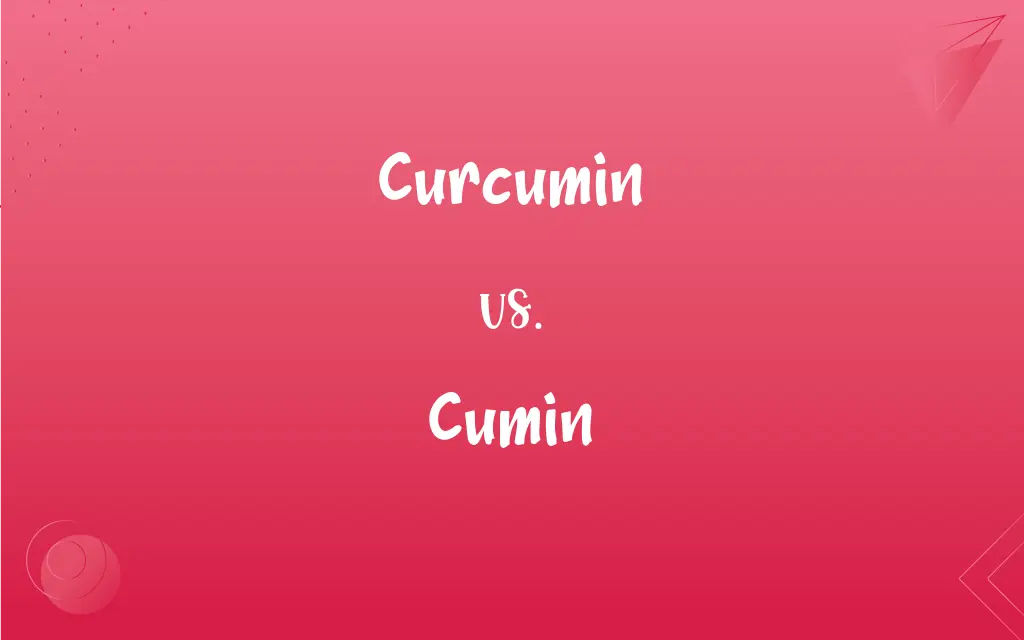Curcumin vs. Cumin: What's the Difference?
Edited by Aimie Carlson || By Harlon Moss || Published on December 29, 2023
Curcumin is a bioactive compound found in turmeric with medicinal properties, while cumin is a spice made from the seeds of the Cuminum cyminum plant, used in cooking.

Key Differences
Curcumin is a chemical compound, specifically a curcuminoid, found in the spice turmeric. Cumin, conversely, is a spice itself, derived from the dried seeds of the Cuminum cyminum plant.
Curcumin is not typically used directly in cooking but is a significant component of turmeric, which flavors and colors food. Cumin is a popular spice used globally, especially in Middle Eastern, Latin American, and Indian cuisines, for its distinct flavor.
Curcumin is known for its anti-inflammatory and antioxidant properties and is used in various health supplements. Cumin, while also having health benefits like aiding digestion, is primarily used as a flavor enhancer in cooking.
Curcumin, as a component of turmeric, contributes to the bright yellow color of the spice. Cumin seeds are small, elongated, and brownish in color, and are used whole or ground in cooking.
Curcumin has been a focus in traditional medicine and modern scientific research for its potential health benefits. Cumin has a long history as a culinary spice and has been valued in various cultures for its flavor and aroma.
ADVERTISEMENT
Comparison Chart
Nature
A bioactive compound in turmeric.
A spice from the seeds of the Cuminum cyminum plant.
Primary Use
Medicinal, for its health benefits.
Culinary, as a flavoring spice in various cuisines.
Health Benefits
Anti-inflammatory, antioxidant properties.
Aids digestion, contains beneficial nutrients.
Physical Form and Color
Yellow compound, part of turmeric powder.
Small, brownish seeds, used whole or ground.
Cultural Significance
Used in traditional medicine, subject of scientific study
Long-standing culinary history in diverse cultures.
ADVERTISEMENT
Curcumin and Cumin Definitions
Curcumin
Curcumin is a bright yellow chemical produced by plants of the Curcuma longa species.
Curcumin is responsible for the yellow color of turmeric powder.
Cumin
Cumin is a spice made from the dried seeds of the Cuminum cyminum plant.
Cumin seeds are essential in many Indian curry recipes.
Curcumin
It is known for its anti-inflammatory and antioxidant properties.
Curcumin supplements are popular for their potential health benefits.
Cumin
It is widely used in culinary traditions around the world for its distinct flavor.
Ground cumin is a key ingredient in Mexican chili dishes.
Curcumin
It is used in traditional medicine and as a dietary supplement.
Curcumin has been used in Ayurvedic medicine for centuries.
Cumin
Cumin seeds are small, elongated, and have a warm, earthy flavor.
Toasted cumin seeds add a nutty flavor to the dish.
Curcumin
Curcumin is a subject of scientific research for its therapeutic potential.
Recent studies focus on curcumin's role in preventing chronic diseases.
Cumin
Cumin has a significant role in various cultural cuisines and traditional medicines.
Cumin has been used for centuries in Middle Eastern cooking.
Curcumin
Curcumin is a curcuminoid, a biologically active compound in turmeric.
The health effects of turmeric are mainly due to its curcumin content.
Cumin
The spice is known for its digestive properties and nutritional benefits.
Cumin is often added to recipes to aid digestion.
Curcumin
A phytochemical found in turmeric and other species in the genus Curcuma that is used in alternative medicine and is purported to have anti-inflammatory and anticancer properties.
Cumin
An annual Mediterranean herb (Cuminum cyminum) in the parsley family, having finely divided leaves and clusters of small white or pink flowers.
Curcumin
(chemistry) A polyphenol (1E,6E)-1,7-bis(4-hydroxy-3-methoxyphenyl)hepta-1,6-diene-3,5-dione; a major constituent of the spice turmeric.
Cumin
The seedlike fruit of this plant used whole or ground for seasoning, as in curry and chili powders.
Curcumin
The coloring principle of turmeric, or curcuma root, extracted as an orange yellow crystalline substance, C14H14O4, with a green fluorescence.
Cumin
Black cumin.
Cumin
The flowering plant Cuminum cyminum, in the family Apiaceae.
Cumin is native to the region from the eastern Mediterranean to India.
Cumin
Its aromatic long seed, used as a spice, notably in Indian, Middle Eastern, and Mexican cookery.
Cumin
A dwarf umbelliferous plant, somewhat resembling fennel (Cuminum Cyminum), cultivated for its seeds, which have a bitterish, warm taste, with an aromatic flavor, and are used like those of anise and caraway.
Rank-smelling rue, and cumin good for eyes.
Cumin
Dwarf Mediterranean annual long cultivated for its aromatic seeds
Cumin
Aromatic seeds of the cumin herb of the carrot family
FAQs
What is cumin?
Cumin is a spice derived from the seeds of the Cuminum cyminum plant.
Are curcumin and cumin the same?
No, curcumin is a compound in turmeric, while cumin is a separate spice.
What are the health benefits of curcumin?
Curcumin is known for anti-inflammatory and antioxidant properties.
Does curcumin have a distinct flavor?
Curcumin itself does not significantly contribute to turmeric's flavor.
Can you take curcumin supplements?
Yes, curcumin supplements are available and used for health benefits.
How is cumin used in cooking?
Cumin is used as a spice, either whole or ground, to flavor dishes.
Is cumin beneficial for health?
Yes, cumin aids digestion and provides various nutrients.
What is curcumin?
Curcumin is a compound found in turmeric, known for its medicinal properties.
Can curcumin be used in cooking?
Curcumin is not typically used alone but as part of turmeric in cooking.
In which cuisines is cumin primarily used?
Cumin is used in Middle Eastern, Indian, Latin American, and North African cuisines.
Is curcumin soluble in water?
Curcumin is poorly soluble in water but soluble in organic solvents.
Does curcumin have any role in cosmetics?
Curcumin is sometimes used in cosmetic products for its antioxidant properties.
Is cumin used in traditional medicine?
Yes, cumin has been used in traditional medicine for digestive issues.
What is the main source of curcumin?
Curcumin is primarily extracted from turmeric root.
What dishes commonly use cumin?
Cumin is commonly used in curries, stews, and spice blends like garam masala.
Are there any side effects of curcumin?
In high doses, curcumin may cause digestive upset or interact with certain medications.
Can curcumin be used as a dye?
Yes, due to its vibrant color, curcumin can be used as a natural dye.
Does curcumin color food?
Yes, curcumin gives turmeric its bright yellow color, which can color foods.
What part of the plant is cumin derived from?
Cumin is derived from the dried seeds of the Cuminum cyminum plant.
Is cumin available in different varieties?
Yes, there are several varieties of cumin, including black cumin and green cumin.
About Author
Written by
Harlon MossHarlon is a seasoned quality moderator and accomplished content writer for Difference Wiki. An alumnus of the prestigious University of California, he earned his degree in Computer Science. Leveraging his academic background, Harlon brings a meticulous and informed perspective to his work, ensuring content accuracy and excellence.
Edited by
Aimie CarlsonAimie Carlson, holding a master's degree in English literature, is a fervent English language enthusiast. She lends her writing talents to Difference Wiki, a prominent website that specializes in comparisons, offering readers insightful analyses that both captivate and inform.






































































